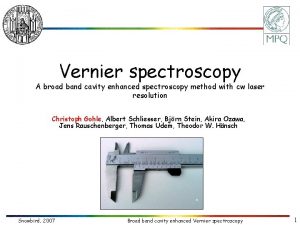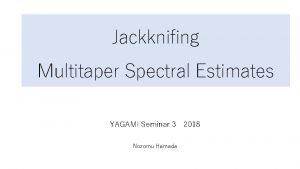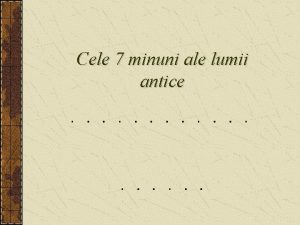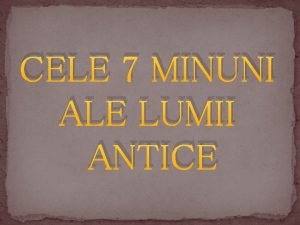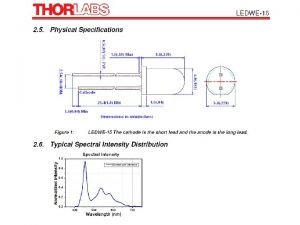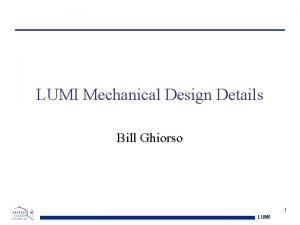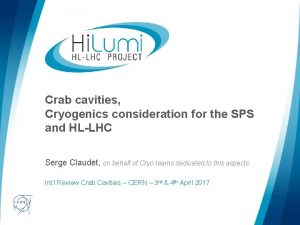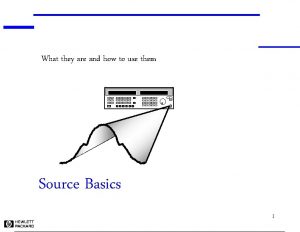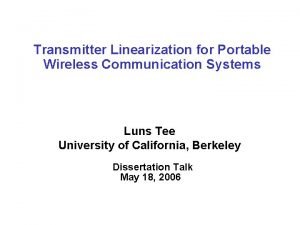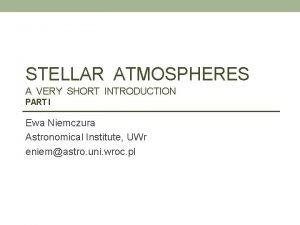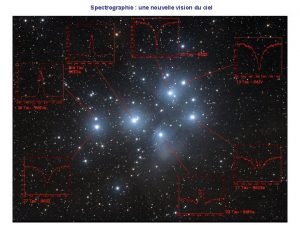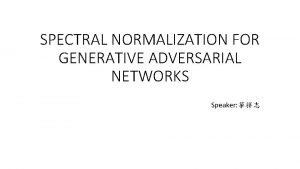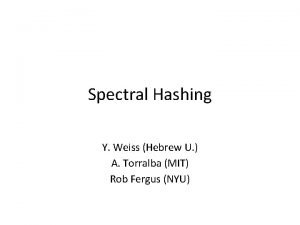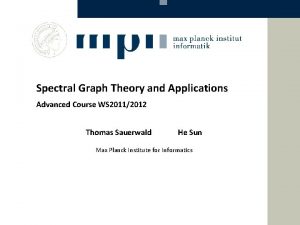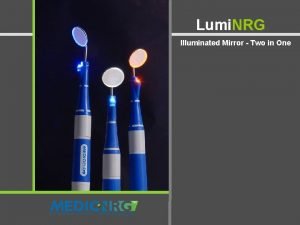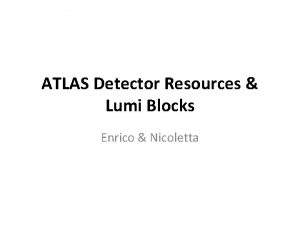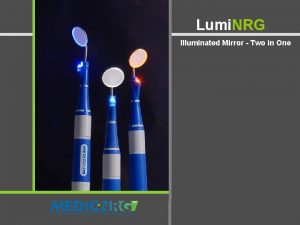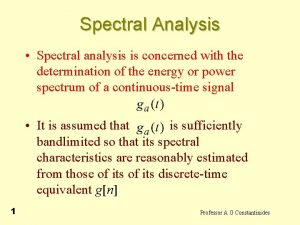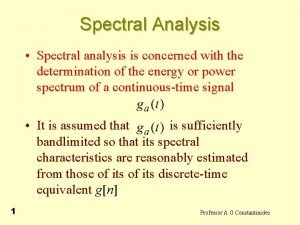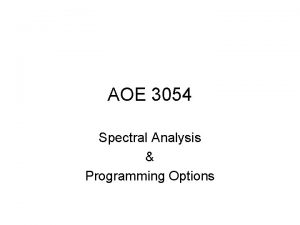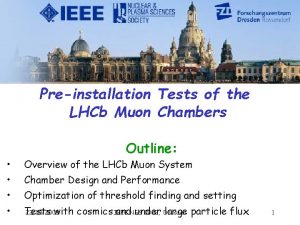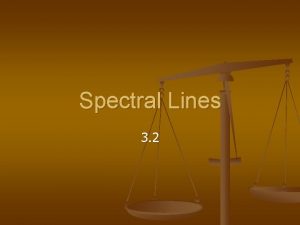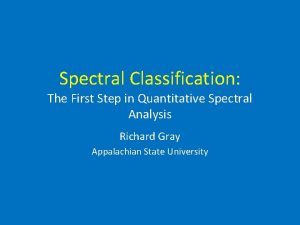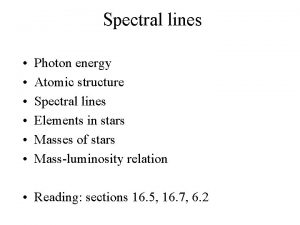Preinstallation spectral response analysis of the Hi Lumi

















![Summary and Questions [1] M. Beech, The Large Hadron Collider: Unravelling the Mysteries of Summary and Questions [1] M. Beech, The Large Hadron Collider: Unravelling the Mysteries of](https://slidetodoc.com/presentation_image_h/12edbc4a0873a35c2c3b46fd8846a3ba/image-18.jpg)

- Slides: 19

Pre-installation spectral response analysis of the Hi. Lumi LHC crab cavity HOM couplers Thermal simulations will also be presented Presenter: Supervisors: Date: logo area James Mitchell (1 st Year Ph. D Student) Graeme Burt (Lancaster University) Rama Calaga (CERN) 23 rd August 2016 ICFA Mini Workshop on Higher Order Modes in Superconducting Cavities 2016 James Mitchell – Lancaster University / the Cockcroft Institute / CERN 1

Introduction and overview § The LHC § The Hi. Lumi Upgrade § Crab cavities § The Double Quarter Wave (DQW) crab cavity § DQW HOM couplers § HOM coupler test boxes § L-bend transmission § Coaxial chamber § Test box manufacture § Future test boxes § High power test box § Thermal simulations James Mitchell – j. a. mitchell@lancaster. ac. uk 2

The LHC and the Hi. Lumi Upgrade § The Large Hadron Collider (LHC) is the largest particle accelerator in the world at 27 km in circumference. § The peak luminosity value for the LHC in current operation is 1 x 1034 cm-2 s-1. § § The High Luminosity Upgrade aims to increase the peak luminosity to 5 x 1034 cm-2 s-1. § § This corresponds to an integrated luminosity value of 40 fb-1 per year. Corresponding to 250 fb-1 per year. One aspect of the upgrade are the superconducting RF crab cavities. Map showing the location and size of the Large Hadron Collider (LHC) [1]. James Mitchell – j. a. mitchell@lancaster. ac. uk 3

The Hi. Lumi upgrade § The Hi. Lumi upgrade aims to increase the luminosity by decreasing the value of β* in the luminosity equation. , § β* is the value of the beta function at the Interaction Point (IP). § However, the mechanisms adopted to achieve this incur a reduction in the crossing angle (θc). Ideal head-on collision and collision with an induced crossing angle for two charged particle bunches. James Mitchell – j. a. mitchell@lancaster. ac. uk 4

Crab cavities – correcting the crossing angle § In order to correct for the luminosity loss, crab cavities are used to rotate the bunches – creating head-on collisions in the lab frame. § Crab Cavities operate in the transverse dipole mode, phased at the zero crossing to provide a rotation of the bunch - this is known as the crabbing regime. § The crab cavity designs selected for the Hi. Lumi upgrade are the Double Quarter Wave (DQW) and Radio Frequency Dipole (RFD). § These will be tested in the SPS in 2018. Crabbing of the bunches to provide head-on collisions in the lab frame. DQW (left) and RFD (right) crab cavities for the Hi. Lumi LHC upgrade [2]. James Mitchell – j. a. mitchell@lancaster. ac. uk 5

Crab cavities – correcting the crossing angle Bunch rotation due to the sinusoidally varying transverse kick. James Mitchell – j. a. mitchell@lancaster. ac. uk 6

Double Quarter Wave (DQW) crab cavity § The DQW was developed at BNL and is now the first of two crab cavities to be tested on the SPS. § In addition to the crabbing mode, there exists several higher order modes (HOMs). § If excited by the beam, these HOMs alter the electromagnetic field within the cavity. § This can have detrimental effects to the particle bunches by: § Accelerating/decelerating. § Adding energy spread, § Providing a kick/rotation. [2] Measured niobium Po. P DQW crab Measured. SS 2121 response of of the aluminium prototype cavity at 2 K. DQW [3]. James Mitchell – j. a. mitchell@lancaster. ac. uk 7

DQW HOM couplers § Use an LC band-stop (a) structure and an Lshaped high-pass filter (b) to achieve the required filter response. § The HOM couplers for the DQW are on-cell couplers. § Better damping is achieved by this. § But the hooks are located in high field. § The HOM couplers were originally designed for the Lancaster 4 -Rod crab cavity and altered for the DQW. § LC band-stop filter is located near the hook so that there is no heating of the copper gasket. § Cooled by immersion in the liquid helium – hollow inner conductor. James Mitchell – j. a. mitchell@lancaster. ac. uk 8

HOM coupler test boxes § Simulation studies show that the HOM couplers are very sensitive to manufacturing tolerances. § Therefore small geometric defects can severely effect the filter response. § Hence a design study for potential test boxes was undertaken. § OBJECTIVE: Can we analyse the spectral response of the HOM couplers before installation? James Mitchell – j. a. mitchell@lancaster. ac. uk 9

L-bend § § § In order to measure the frequency response of the HOM coupler reliably, a probe design is required which accurately reproduces the coupler response. Several coupling techniques were trialled. Best method’s had an inductive path to ground. James Mitchell – j. a. mitchell@lancaster. ac. uk 10

L-bend § § § Multi-port system designed. Low power spectral analysis. This design also allows high power testing, i. e. a transmission of power from HOM coupler port to the other. § Validation possible with multiple ports. § Inherent symmetry improved response. § Can still use one coupler – blanking plate. § 1 Reproduces the 400 MHz rejection very well. 2 400 MHz Frequency of the deflecting mode James Mitchell – j. a. mitchell@lancaster. ac. uk 11

Coaxial chamber § Four port symmetrical device. § Uses an ‘off-the-shelf’ coaxial line with connectors which allow reduction to 716/N-type. § 1 2 Robust system as manufacturing tolerances are not § However this means that optimisation parameters are very limited. § Worse representation of the deflecting mode frequency. § Another Po. P for high power test box. James Mitchell – j. a. mitchell@lancaster. ac. uk 12

Manufacture HOM Coupler L-bend test box body Coaxial chamber – 3 -1/8”coax line James Mitchell – j. a. mitchell@lancaster. ac. uk 13

High power conditioning § High transmission between HOM ports needed for conditioning. § DQW Fundamental Power Couplers (FPC) test boxes designed with this principle. 3 2 DQW FPC test box for high power conditioning. James Mitchell – j. a. mitchell@lancaster. ac. uk 15

Thermal simulations § The electrical and thermal conductivities of Niobium vary with temperature significantly in the super conducing regime (0 -9 K). § Previously, this has been taken into account in post processing. § However, CST MWS allows this to be taken into account. [4] James Mitchell – j. a. mitchell@lancaster. ac. uk 16

Thermal simulations § Thermal loss map created from Eigenmode simulation. § CST normalises the fields in the cavity to 1 J stored energy – fields re-normalised to nominal values during operation. § Temperature of couplers can then be inferred. § Currently – The new electrical and thermal conductivities need to be imported back into the EM simulation and this process needs to be iterated. § This will allow the variable electrical and thermal conductivities to be accounted for. James Mitchell – j. a. mitchell@lancaster. ac. uk 17

Thermal simulations § Next steps… § Take into account that there is a magnetic field present which varies due to the location of the magnetic shield. § To do this, the coupler will be split into sections and the residual resistance of each section will be changed to correspond to the value of the external magnetic field. [5] James Mitchell – j. a. mitchell@lancaster. ac. uk 18
![Summary and Questions 1 M Beech The Large Hadron Collider Unravelling the Mysteries of Summary and Questions [1] M. Beech, The Large Hadron Collider: Unravelling the Mysteries of](https://slidetodoc.com/presentation_image_h/12edbc4a0873a35c2c3b46fd8846a3ba/image-18.jpg)
Summary and Questions [1] M. Beech, The Large Hadron Collider: Unravelling the Mysteries of the Universe. Springer Science & Business Media, 2010. 6 th [2] W. Qiong, Crab Cavities: Past, Present and Future of a Challenging Device. [3] M. Navarro, Bead-Pull Measurements on the Fundamental Mode of the Double-Quarter-Wave Crab Cavity, CERN-ACC-NOTE-2015 -0020. International Particle Accelerator Conference, May 3 -8, 2015. [4] P. Dhakal, Superconducting DC and RF properties of Ingot Niobium. Thomas Jefferson National Accelerator Facility, CA 23606, US. [5] C. Zanoni, Magnetic shielding simulations for the Double Quarter Wave (DQW) crab cavity, Work Package 4, Hi. Lumi LHC, CERN. Special thanks go to: R. Apsimon A. Bucherie J. Gates E. Montisinos J. A. Mitchell. et al. LHC Crab Cavity Coupler Test Boxes. in Proc. IPAC 16, Busan, Korea, May. 2016, paper WEPMB 058, pp. 2248 -2250. Computer Simulation Technology, Bad Nauheimer Str. 19 D-64289 Darmstadt Germany, http: //www. cst. com. James Mitchell j. a. mitchell@lancaster. ac. uk 19

Other HOM related work § DQW mechanical tuner tests at 2 K. § The spectral response of the deflecting mode and two HOMs were taken at various positions of the motor. § The frequency deviation per step and hysteresis loss could be quantified for each of the resonances looked at. § The measurements of the HOMs will allow us to calculate the RRR by taking the ratios of the Q-factors at ~10 K and 300 K. § Full spectral analysis of DQW at 2 K from 350 MHz to 2 GHz. This is difficult with the deflecting mode as it is very weakly coupled at 300 K and thus it is difficult to get a Q-factor from this. Example of method used to quantify effect of mechanical tuner on HOM frequency. James Mitchell – j. a. mitchell@lancaster. ac. uk 20
 Vernier spectroscopy
Vernier spectroscopy Yagami doc
Yagami doc Lumi della ragione
Lumi della ragione 7 minuni ale lumii
7 minuni ale lumii Cele 7 'minuni ale lumii
Cele 7 'minuni ale lumii Tlv: lumi
Tlv: lumi Phillips lumi
Phillips lumi Second chances lumi
Second chances lumi Lumi rossi
Lumi rossi Lumi sps
Lumi sps Natural response and forced response
Natural response and forced response Natural response circuit
Natural response circuit A subsequent
A subsequent Spectral regrowth
Spectral regrowth Spectral regrowth
Spectral regrowth Spectral classification
Spectral classification Profil spectral rigel
Profil spectral rigel Spectral normalization for generative adversarial networks
Spectral normalization for generative adversarial networks Hashing
Hashing Spectral graph theory course
Spectral graph theory course
